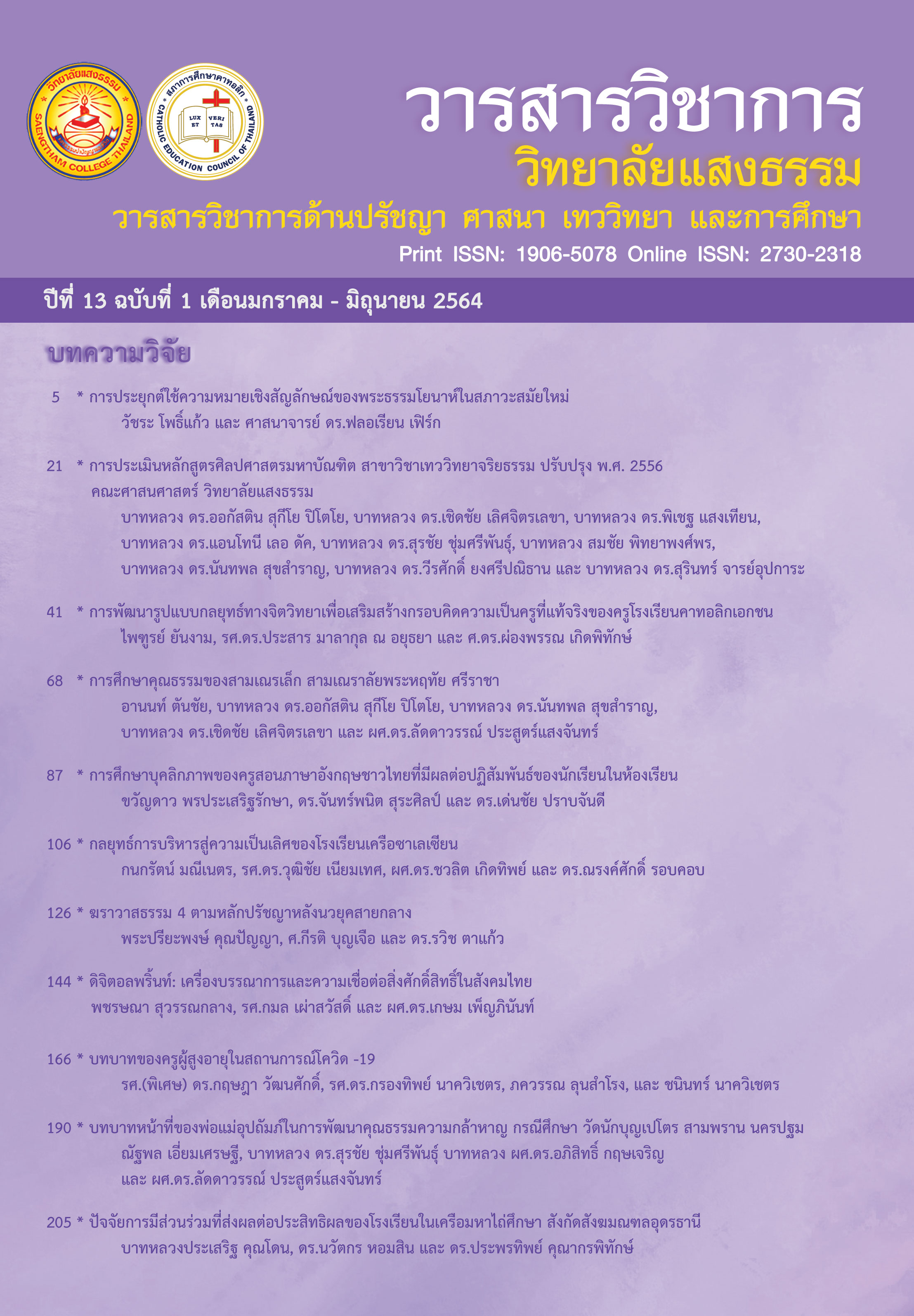การศึกษาบุคลิกภาพของครูสอนภาษาอังกฤษชาวไทย ที่มีผลต่อปฏิสัมพันธ์ของนักเรียนในห้องเรียน
Main Article Content
บทคัดย่อ
งานวิจัยมีวัตถุประสงค์ เพื่อศึกษาบุคลิกภาพของครูชาวไทยที่สอนภาษาอังกฤษ ในจังหวัด สุราษฎร์ธานีและผลกระทบของบุคลิกภาพของครูต่อปฏิสัมพันธ์ของนักเรียนในชั้นเรียน โดยใช้การวิจัยแบบผสมผสาน ระหว่างการวิจัยเชิงปริมาณและเชิงคุณภาพ กลุ่มตัวอย่างคือ ครูสอนภาษาอังกฤษชาวไทย จากโรงเรียนเอกชน และโรงเรียนรัฐบาลในจังหวัดสุราษฎร์ธานี ในระดับชั้นประถมศึกษาปีที่ 1 ถึง มัธยมศึกษาปีที่ 6 จำนวน 100 คน เครื่องมือที่ใช้ในงานวิจัยคือ แบบวัดบุคลิกภาพ 5 รูปแบบ โดยในส่วนของการวิจัยเชิงปริมาณได้ใช้ แบบวัดบุคลิกภาพ 5 คุณลักษณะ จำนวน 44 ข้อ ในการเก็บข้อมูล ผลการวิจัยพบว่า ครูสอนภาษาอังกฤษชาวไทยส่วนใหญ่มีบุคลิกภาพแบบประนีประนอมโดยมีจำนวน 44 คน จากตัวอย่าง 100 คน ในขณะที่บุคลิกภาพแบบเปิดรับประสบการณ์มีเพียง 3 คน จากตัวอย่าง 100 คน จากนั้นใช้ รูปแบบการวิจัยเชิงคุณภาพ เพื่อศึกษาอิทธิพลของบุคลิกภาพของครู ที่มีต่อปฏิสัมพันธ์กับผู้เรียนในห้องเรียน มีเก็บข้อมูลจากการสังเกตการเรียนการสอนในชั้นเรียน การบันทึกวีดีโอการเรียนการสอนในชั้นเรียนและการสัมภาษณ์ครูผู้สอน โดยทำการศึกษาจากครูผู้สอนจำนวน 5 คนที่ผ่านเกณฑ์คัดเลือกที่กำหนดไว้ ผลการวิจัยชี้ให้เห็นว่า บุคลิกภาพของครูที่แสดงออกทางพฤติกรรมในขณะทำการสอนนั้นส่งผลต่อปฏิสัมพันธ์ของนักเรียนในห้องเรียน
Article Details
- บทความที่ได้รับการตีพิมพ์ในวารสารวิชาการ วิทยาลัยแสงธรรม ถือเป็นกรรมสิทธิ์ของวิทยาลัยแสงธรรม ห้ามนำข้อความทั้งหมดไปตีพิมพ์ซ้ำ ยกเว้นได้รับอนุญาตจากวิทยาลัยแสงธรรม
- เนื้อหาและข้อคิดเห็นใดๆ ที่ตีพิมพ์ในวารสารวิชาการ วิทยาลัยแสงธรรม ถือเป็นความรับผิดชอบของผู้เขียนเท่านั้น
References
Borg, S. (2006). The distinctive characteristics of foreign language teachers. Language Teaching Research, 10(1), 3-31.
Cawvey, M., Hayes M., Canache D., & and Mondak, J. J. (Jan, 2017). Personality and Political Behavior. Oxford Research Encyclopedia of Politics. Doi: 10.1093/acrefore/9780190228637.013.221
Fenderson, P. R. (2011). Personality Characteristics of 2009 National Teacher of the Year Candidates. Walden University.
Hakimi, S., Hejazi, E., & Lavasani, M. G. (2011). The relationships between personality traits and students’ academic achievement. Procedia-Social and Behavioral Sciences, 29, 836-845.
Hattie, J, (2003). Teachers Make a Difference What is the research evidence? In Australian Council for Educational Research (ACER). Retrieved from http://research.acer.edu.au/cgi/viewcontent.cgi?article=1003&context=research_conference_2003
Higgins, C. (2011). Teacher-student Relationship Development: A Qualitative Study of Interpersonal Connecti0ns in an Early Childhood Classroom. (Electronic Thesis or Dissertation). Retrieved from https://etd.ohiolink.edu/
John, O. P., Donahue, E. M., & Kentle, R. L. (1991). The Big Five Inventory-Versions 4a and 54. Berkeley, CA: University of California, Berkeley, Institute of Personality and Social Research.
Jurczak, I., & Jurczak, E. (2015). Personality of the Teacher as an Important Element in the Educational Process of the Child. Pedagogika Rodziny, 5(2), 79-88.
Kanoksilapatham, B. (2016). Promoting Global English while Forging Young Northeastern Thai Learners’ Identity. 3L: Language,Linguistics, Literature®, 22(3).
Kyriakides, L., Creemers, B. P., & Antoniou, P. (2009). Teacher behavior and student outcomes: Suggestions for research on teacher training and professional development. Teaching and teacher education, 25(1), 12-23.
Lotfi, M., Muktar, S. N. B., Ologbo, A. C., & Chiemeke, K. C. (2016). The influence of the big-five personality traits dimensions on knowledge sharing behavior. Mediterranean Journal of Social Sciences, 7(1 S1), 241.
Masruddin, M. M., & Pratiwi, H. H. (2016). Students’ perception and Their Attitude Towards English Teachers’ Personality. Langkawi: Journal of The Association for Arabic and English, 2(2), 202-218.
Morgan, B., & De Bruin, K. (2010). The relationship between the big five personality traits and burnout in South African university students. South African Journal of Psychology, 40(2), 182-191.
Moussa, W. S. (2013). Essays on academic achievement and student behavior in public schools (Doctoral dissertation, Syracuse University). Retrieved from https://surface.syr.edu/
Mulyanegara, R. C., Tsarenko, Y., & Anderson, A. (2009). The Big Five and brand personality: Investigating the impact of consumer personality on preferences towards particular brand personality. Journal of Brand Management, 16(4), 234-247.
Perlman, D. J. & Pearson, P. (2012). A comparative analysis between primary and secondary teachers: A self-determination perspective. The Shield: research journal of physical education and sports science, 7, 8-17.
Rowe, Ken, (2003). The Importance of Teacher Quality As A Key Determinant of Students’ Experiences and Outcomes of Schooling. Retrieved from https://research.acer.edu.au/research_conference_2003/3
Sehgal, M. & Karu (1995). Teacher as an Agent of Mental Health: A Cross Cultural Confirmation. Proceedings of World Congress of Cultural Psychiatry, March.
Yasseen, B. M. B. (2010, February). The effect of teachers' behavior on students' behavior in the classroom. In International Forum of Teaching and Studies, 6(1). 48-57.

